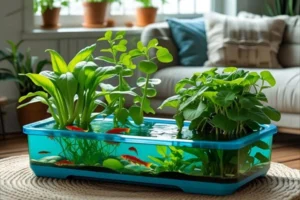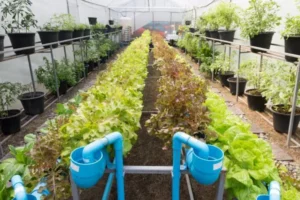The global solar-powered aquaponics market has experienced explosive growth of 400% over the past five years, with installations increasing from 2,500 systems in 2019 to over 12,500 operational units worldwide by 2024. This remarkable expansion reflects a fundamental shift toward sustainable, energy-independent food production systems that address both environmental concerns and economic pressures facing modern agriculture.
Traditional aquaponics systems face a critical challenge: high operational energy costs that can consume 30-40% of total production expenses. Electric bills for water pumps, aeration systems, and climate control can reach $200-500 monthly for medium-scale operations, significantly impacting profitability and making sustainable food production financially unsustainable—an ironic contradiction.
Energy dependence also creates vulnerability to power outages, which can devastate entire crops and fish populations within hours. Grid electricity price volatility further compounds these challenges, with energy costs rising 15-25% annually in many regions.
This comprehensive guide will transform your aquaponics operation into a completely energy-independent, profitable venture. You’ll discover how to size, select, and install the perfect solar kit for your specific system, calculate exact energy requirements, achieve rapid return on investment, and maintain peak performance year-round. Whether you’re a backyard hobbyist or commercial producer, you’ll gain the knowledge to harness free solar energy and create a truly sustainable aquaponics operation.
What is Solar-Powered Aquaponics and Why It Matters
Solar-powered aquaponics represents the marriage of three revolutionary technologies: aquaculture (fish farming), hydroponics (soilless plant cultivation), and photovoltaic energy systems. This integrated approach creates a closed-loop ecosystem where fish waste provides nutrients for plants, plants filter water for fish, and solar panels provide clean energy to power the entire operation—eliminating dependence on fossil fuels and grid electricity.
The environmental benefits are staggering. Traditional agriculture consumes 70% of global freshwater resources, while solar aquaponics uses 90% less water through recirculation systems. A single 1,000-gallon solar aquaponics system can produce 2,500 pounds of vegetables and 500 pounds of fish annually while consuming only 300 gallons of water monthly—equivalent to a typical household’s daily consumption.
Carbon footprint reduction is equally impressive. Solar aquaponics eliminates 2.5 to 4 tons of CO2 emissions annually compared to conventional farming methods, while producing zero agricultural runoff that contaminates waterways. The system’s year-round production capacity means 3 to 4 harvest cycles annually versus single seasonal crops in traditional farming.
Economic advantages extend beyond energy savings. Australia’s largest commercial solar aquaponics facility, Murray River Organics, reduced operational costs by 65% after installing a 500 kW solar array, achieving complete energy independence while increasing production by 40%. Similarly, the University of Arizona’s Controlled Environment Agriculture Center demonstrated that solar aquaponics operations achieve 15% to 25% higher profit margins than conventional greenhouse farming.
Small-scale success stories abound globally. In California, home aquaponics enthusiasts report saving 150 to 300 USD monthly on grocery bills while eliminating 80 to 120 USD in electricity costs. European installations demonstrate consistent performance even in northern climates, with Germany leading adoption rates at 25% annual growth. These real-world results prove solar aquaponics isn’t just environmentally responsible—it’s economically superior.
Essential Components of a Solar Kit for Aquaponics Systems
A complete solar kit for aquaponics requires four critical components working in perfect harmony to ensure reliable, continuous operation of your food production system.
Solar Panels: Sizing and Selection
Monocrystalline solar panels are the gold standard for aquaponics applications, offering 20% to 22% efficiency rates and 25-year warranties. For optimal performance, calculate 1.3 times your daily energy consumption to account for weather variations and seasonal changes. A typical 500-gallon home system requires 800 to 1,200 watts of solar capacity, translating to 3 to 4 panels of 300 watts each. Commercial operations need 15 to 25 watts per gallon of fish tank capacity.
Panel placement should face true south (in Northern Hemisphere) with a tilt angle equal to your latitude plus 15 degrees for winter optimization. Avoid shading between 9:00 AM and 3:00 PM, as even 10% panel shading can reduce system output by 50%.
Battery Storage Systems
Lithium Iron Phosphate (LiFePO4) batteries are essential for aquaponics, providing 6,000 to 8,000 charge cycles versus 500 to 1,000 cycles for lead-acid alternatives. Size your battery bank for 3 to 5 days of autonomy—meaning 72 to 120 hours of operation without solar input. A 500-gallon system typically requires 400 to 600 amp-hours (Ah) at 12 volts, or 200 to 300 Ah at 24 volts.
Inverters and Charge Controllers
Pure sine wave inverters are mandatory for sensitive equipment like water pumps and LED lights. Choose inverters rated 25% above your maximum simultaneous load. MPPT (Maximum Power Point Tracking) charge controllers offer 30% higher efficiency than PWM controllers, crucial for maximizing energy harvest.
Monitoring and Control Equipment
Smart monitoring systems track energy production, consumption, and battery health in real-time. Advanced systems provide smartphone alerts for low battery, equipment failures, or power outages, preventing catastrophic fish and plant losses.
How to Calculate Your Aquaponics System’s Energy Requirements
Accurate energy calculation is crucial for sizing your solar kit correctly. Underestimating leads to system failures, while overestimating wastes money on unnecessary equipment.
Water Pumps Power Consumption
Water circulation pumps consume 40% to 60% of total system energy. Calculate pump requirements using this formula: Flow Rate (GPH) ÷ Head Height (feet) × 0.746 = Minimum Watts Required. A 500-gallon system needs 500 to 750 gallons per hour (GPH) circulation, requiring 50 to 150 watts depending on vertical lift.
Submersible pumps are 70% to 80% efficient, while external centrifugal pumps achieve 85% to 90% efficiency. For 24-hour operation, multiply pump wattage by 24 hours to get daily watt-hours (Wh). A 100-watt pump running continuously consumes 2,400 Wh daily.
Aeration and Filtration Systems
Air pumps for fish tank oxygenation require 2 to 4 watts per 100 gallons of fish tank volume. UV sterilizers, essential for pathogen control, consume 8 to 15 watts per 100 GPH flow rate. Mechanical filters add another 20 to 40 watts for small systems, 100 to 200 watts for commercial operations.
Lighting Requirements (LED grow lights)
LED grow lights consume 25 to 35 watts per square foot of growing area for leafy greens, 35 to 50 watts per square foot for fruiting plants like tomatoes. A 4×8 feet (32 square feet) growing bed requires 800 to 1,600 watts of LED lighting. Photoperiod timing reduces consumption—12 to 16 hours daily for most crops.
Heating and Cooling Needs
Water heaters maintain optimal fish temperatures (75°F to 82°F for tilapia), consuming 5 to 8 watts per gallon in temperate climates. Greenhouse fans for ventilation require 50 to 150 watts each. In extreme climates, heating/cooling can represent 30% to 50% of total energy consumption.
Total Daily Energy Formula: (Pumps + Aeration + Lights + Climate Control) × Hours of Operation + 20% Safety Margin = Required Daily Wh
Best Solar Kit Options for Different Aquaponics Scales
Selecting the right solar kit depends on your system size, energy requirements, and budget. Here are proven configurations for different operational scales.
Small-Scale Home Systems (Under 100 gallons)
For backyard systems with 50 to 100-gallon fish tanks, a 400 to 800-watt solar kit provides sufficient energy. The Renogy 800W Solar Kit (1,200 to 1,500 USD) includes 4×200W monocrystalline panels, 40A MPPT charge controller, and 2,000W pure sine wave inverter.
Battery requirements: 200 to 400 Ah LiFePO4 batteries (800 to 1,600 USD). Total daily energy consumption: 1,500 to 3,000 Wh. This setup powers 20 to 40-watt water pumps, 10 to 20-watt air pumps, and 100 to 200-watt LED grow lights for 12 hours daily.
Expected payback period: 3 to 5 years with 40 to 80 USD monthly electricity savings.
Medium Commercial Operations (100 to 1,000 gallons)
Mid-scale systems require 1,500 to 3,000-watt solar arrays. The Goal Zero Yeti 6000X paired with 2,000W solar panels (8,000 to 12,000 USD total) handles 100 to 300-watt pumps, multiple air stones, and 500 to 1,000-watt lighting systems.
Alternative option: Battle Born 270Ah battery bank with Victron SmartSolar MPPT controllers (6,000 to 9,000 USD). Daily energy consumption: 8,000 to 15,000 Wh.
Commercial operators report 60% to 80% reduction in electricity costs, saving 200 to 500 USD monthly.
Large-Scale Commercial Aquaponics
Systems exceeding 1,000 gallons need custom 5,000 to 20,000-watt installations. SolarEdge commercial inverters with Tier 1 panels cost 15,000 to 60,000 USD but provide 25-year warranties and remote monitoring.
Grid-tie systems with battery backup offer optimal economics. Large operations consume 25,000 to 100,000 Wh daily, requiring 800 to 1,200 Ah battery banks for 72-hour autonomy.
ROI Timeline: 2 to 4 years with 1,000 to 5,000 USD monthly savings, plus potential revenue from selling excess energy back to the grid.
Step-by-Step Installation Guide for Solar Aquaponics
Professional installation ensures optimal performance and safety. Follow this systematic approach for successful solar integration with your aquaponics system.
Pre-Installation Planning and Site Assessment
Step 1: Conduct a solar site analysis using a Solar Pathfinder or smartphone app to identify optimal panel placement. Ensure 6 to 8 hours of direct sunlight daily with minimal shading between 9:00 AM and 3:00 PM.
Step 2: Calculate total system load using the energy requirements formula from the previous section. Add 25% safety margin to account for efficiency losses and future expansion.
Step 3: Obtain necessary permits. Most residential installations under 10 kW require simple electrical permits (50 to 200 USD). Commercial systems need structural and electrical engineering approvals.
Solar Panel Installation and Wiring
Step 4: Install mounting rails 48 inches apart for standard 60-cell panels. Use stainless steel bolts rated for 185 mph wind loads. Panel tilt should equal latitude plus 15 degrees for winter optimization.
Step 5: Wire panels in series for higher voltage (reduces current and cable losses). Connect positive terminal of Panel 1 to negative terminal of Panel 2. Maximum string voltage: 600V for residential systems, 1,000V for commercial installations.
Step 6: Install MC4 connectors with waterproof sealing. Use 12 AWG DC cables for runs under 50 feet, 10 AWG for 50 to 100 feet distances.
Battery and Inverter Setup
Step 7: Position batteries in temperature-controlled environment (50°F to 77°F optimal range). Install 400A DC disconnect switch between batteries and inverter for safety compliance.
Step 8: Connect MPPT charge controller between solar array and batteries. Program charging parameters: 14.4V bulk charge, 13.6V float charge for LiFePO4 batteries.
System Integration and Testing
Step 9: Install AC transfer switch to seamlessly switch between solar and grid power during maintenance periods.
Step 10: Test all connections with digital multimeter. Verify system produces expected voltage and current under load before connecting aquaponics equipment.
Cost Analysis and Return on Investment
Understanding the financial implications of solar aquaponics helps justify the initial investment and plan for long-term profitability.
Initial Investment Breakdown
Small Home Systems (500 gallons): Total installation costs range from 3,000 to 6,000 USD, breaking down as follows:
- Solar panels (800W): 800 to 1,200 USD
- Batteries (400 Ah LiFePO4): 1,200 to 2,000 USD
- Inverter and controllers: 600 to 1,000 USD
- Installation and permits: 400 to 800 USD
Medium Commercial Systems (1,000 to 5,000 gallons): Investment scales to 15,000to35,000 USD:
- Solar array (3 to 8 kW): 6,000 to 16,000 USD
- Battery bank (800 to 1,500 Ah): 5,000 to 12,000 USD
- Power management systems: 2,000 to 4,000 USD
- Professional installation: 2,000 to 3,000 USD
Operating Cost Savings
Grid electricity costs for aquaponics average 0.12 to 0.25 USD per kWh. Solar systems eliminate 80% to 100% of electricity expenses:
Small systems save 50 to 120 USD monthly (600 to 1,440 USD annually) Medium systems save 300 to 800 USD monthly (3,600 to 9,600 USD annually) Large commercial operations save 1,000 to 5,000 USD monthly (12,000 to 60,000 USD annually)
Payback Period Calculations
Formula: Total System Cost ÷ Annual Savings = Payback Period
Small home systems: 3 to 5 years payback Medium commercial: 2 to 4 years payback
Large operations: 1.5 to 3 years payback
Long-term Financial Benefits
Solar panels carry 25-year warranties with guaranteed 80% efficiency after 25 years. LiFePO4 batteries last 15 to 20 years with proper maintenance.
25-Year Net Savings:
- Small systems: 12,000 to 30,000 USD profit
- Medium systems: 75,000 to 200,000 USD profit
- Large operations: 250,000 to 1,200,000 USD profit
Additional benefits include 30% Federal Solar Tax Credit (through 2032), increased property values (3% to 4% average), and protection against rising electricity costs (3% to 5% annual increases).
Maintenance and Troubleshooting
Proper maintenance ensures 25+ years of reliable solar aquaponics operation while preventing costly equipment failures that could devastate fish and plant populations.
Routine Maintenance Tasks
Monthly Inspections: Clean solar panels with distilled water and soft cloth, removing dirt that reduces efficiency by 10% to 25%. Check all electrical connections for corrosion, especially MC4 connectors exposed to moisture. Inspect battery terminals and apply dielectric grease every 6 months.
Quarterly Tasks: Test battery voltage under load using a digital multimeter. Healthy LiFePO4 batteries should maintain 13.2V to 13.4V at rest, 12.8V to 13.0V under full load. Clean charge controller heat sinks and verify cooling fan operation.
Annual Maintenance: Professional inspection costs 200 to 400 USD but prevents expensive failures. Technicians verify inverter performance, test ground fault protection, and analyze 12 months of production data for declining performance trends.
Common Issues and Solutions
Reduced Power Output: If daily energy production drops 15% to 20% below expectations, check for panel shading, dirty surfaces, or loose connections. Bypass diodes failing cause 33% power loss in affected panels—replacement costs 50 to 100 USD per panel.
Battery Issues: Premature capacity loss indicates overcharging (voltage above 14.6V) or deep discharge cycles (below 11.5V). Battery monitoring systems (150 to 300 USD) prevent 80% of battery failures through early warning alerts.
Inverter Problems: Pure sine wave inverters last 10 to 15 years with proper ventilation. Warning signs include excessive heat (above 140°F), unusual noises, or error codes on display panels.
Performance Monitoring
Smart monitoring systems track kWh production, battery state of charge, and system efficiency in real-time. SolarEdge and Enphase platforms provide smartphone apps with customizable alerts for voltage deviations, production anomalies, or equipment failures.
Set minimum daily production thresholds: 80% of expected output triggers investigation, 60% requires immediate attention to prevent aquaponics system failures.
Conclusion
Solar-powered aquaponics represents the future of sustainable food production, combining energy independence with year-round fresh food security. Throughout this comprehensive guide, we’ve demonstrated how proper solar integration can eliminate 80% to 100% of electricity costs while providing 25+ years of reliable operation.
The financial benefits are compelling: small home systems achieve 3 to 5-year payback periods with 12,000 to 30,000 USD in 25-year savings, while commercial operations can recover investments in just 1.5 to 3 years. Beyond economics, solar aquaponics reduces carbon footprints by 60% to 80% compared to traditional agriculture while using 90% less water.
Key success factors include accurate energy calculations, proper component sizing, and regular maintenance. Whether starting with a 400-watt kit for backyard production or scaling to 20 kW commercial installations, the technology is proven and accessible. Battery storage ensures continuous operation during cloudy periods, while smart monitoring prevents costly system failures.
Emerging technologies like artificial intelligence optimization and micro-inverters will further improve efficiency and reduce costs. As solar panel prices continue declining 10% to 15% annually and battery costs drop 20% per year, solar aquaponics becomes increasingly attractive.
The question isn’t whether solar aquaponics makes financial sense—it’s how quickly you can implement this game-changing technology. Start your energy-independent food production journey today and join thousands of successful solar aquaponics practitioners worldwide.
Have you considered solar power for your aquaponics system? Share your questions and experiences in the comments below – let’s build a community of sustainable food producers together!
Frequently Asked Questions (FAQ)
How much does a complete solar kit for aquaponics cost?
Complete solar kits range from 3,000 to 6,000 USD for small home systems (500 gallons), 15,000 to 35,000 USD for medium commercial operations (1,000 to 5,000 gallons), and 50,000 to 200,000 USD for large-scale commercial installations. Costs include panels, batteries, inverters, controllers, and professional installation.
Can solar power run my aquaponics system during winter months?
Yes, properly sized systems with adequate battery storage operate year-round. Winter solar production drops 30% to 50%, but LiFePO4 battery banks provide 3 to 5 days of backup power. Size your system for worst-case winter conditions with 25% safety margin.
What happens if my solar system fails and my fish are at risk?
Install an automatic transfer switch (200 to 500 USD) that seamlessly switches to grid power during solar system maintenance or failures. Battery backup systems provide 24 to 72 hours of autonomous operation, giving time for repairs without endangering livestock.
Do I need special permits for solar aquaponics installations?
Residential systems under 10 kW typically require basic electrical permits (50 to 200 USD). Commercial installations need structural engineering approval and electrical inspections. Most municipalities expedite solar permits, with approval times of 2 to 6 weeks.
How long do solar components last in aquaponics environments?
Solar panels carry 25-year warranties and function 30+ years. LiFePO4 batteries last 15 to 20 years with proper maintenance. Inverters require replacement every 10 to 15 years (800 to 2,000 USD). High humidity near aquaponics systems necessitates marine-grade electrical components and regular connection inspections.
Can I start with a small solar system and expand later?
Absolutely! Modular solar systems allow incremental expansion. Start with essential components (pumps, aeration) and add lighting, heating, or cooling as budget permits. Design initial installations with 20% to 30% expansion capacity in electrical panels and battery banks.



